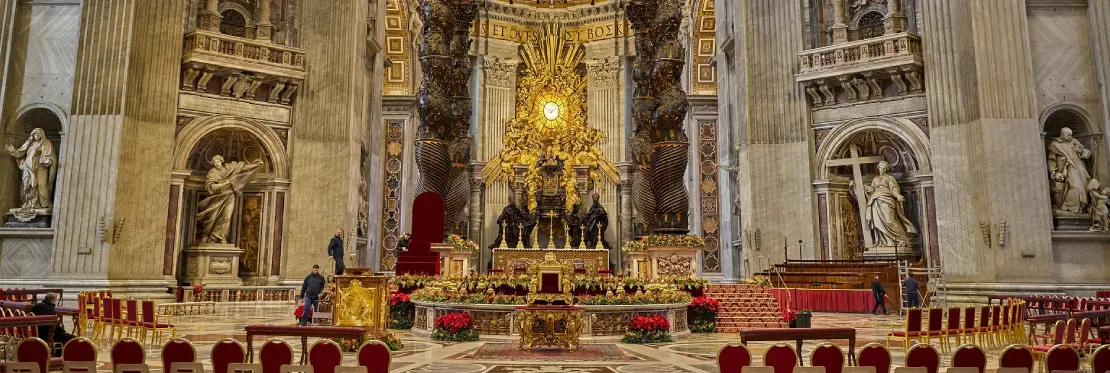
A guided tour of St. Peter's Basilica.
In the heart of Vatican City lies St. Peter's Square, an open space built by Bernini in the 17th century, which precedes the nerve center of the papal city: St. Peter's Basilica. This square, surrounded by 284 columns and 140 statues of saints, can host liturgies for over 300,000 people. This is the ideal starting point for discovering the Vatican. Today, we present a brief tour of St. Peter's Square and Basilica to make sure you don’t miss any details during your visit.
Brief history of St. Peter's Square and Basilica
The history of St. Peter's Basilica begins in the 4th century when Constantine decided to build a religious temple over the place where the apostle St. Peter was buried.
However, that initial construction was replaced by the current Basilica on the orders of Pope Julius II between 1506 and 1629. Various architects, such as Donato Bramante, Raphael, Antonio da Sangallo, and Michelangelo, worked on this project, with Michelangelo giving the design its final shape. The interior was decorated by Bernini.
Meanwhile, St. Peter's Square was constructed between 1656 and 1667 by Bernini and his disciples under the direction of Pope Alexander VII, with the aim of providing a space to host visitors gathered to receive the Pope's blessing. Its central obelisk, columns, and 140 figures of saints invite visitors to take a closer look, thanks to their important symbolism and religious significance.
Today, St. Peter's Basilica is the largest in the world, with a total area of 23,000 square meters, which takes several hours to explore. Given the number of details in these spaces, we recommend taking a guided Vatican tour to ensure you don’t miss any key aspects.
Main works of art you can see on your visit to St. Peter's Basilica
Over the centuries, St. Peter's Basilica has become not only the world's main ecclesiastical temple but also an important artistic space that houses works of great relevance in the history of world art.
Vatican Pietà by Michelangelo Buonarroti (1499)
This marble sculpture by Michelangelo is the star attraction of any visit to St. Peter's Basilica and one of the most important sculptures of the Italian Renaissance. It depicts the Virgin Mary, draped in garments with striking folds, holding the body of her son.
The level of detail in the expressions, bodies, and garments is truly impressive, especially considering Michelangelo’s age when he sculpted this masterpiece: he was only 23 to 25 years old at the time.
The work is located in the Chapel of the Crucifix, as soon as you enter, to the right, and it alone constitutes a compelling reason to get tickets for St. Peter's Basilica.
Bronze Statue of St. Peter attributed to Arnolfo di Cambio (1300)
On the right side of the central nave is another of the Basilica’s main sculptures: the statue of St. Peter the Apostle, also known as "The Fisherman," attributed to Arnolfo di Cambio. Unlike most of the sculptures in the complex, which were created during the Renaissance, this bronze work was sculpted in the Middle Ages.
If you visit the Basilica and the Vatican Museums during St. Peter's feast day (June 29) or the Feast of the Chair of St. Peter (February 22), you’ll see it adorned with papal ornaments, celebrating the figure recognized as the first Pope in history.
Tomb of Alexander VII by Gian Lorenzo Bernini (1678)
Like many other ecclesiastical buildings worldwide, St. Peter's Basilica contains the tombs of figures tied to its history. Since this Basilica is the main one in the Catholic Church and the headquarters of the Vatican City State, most papal tombs are located in this temple, many of them accompanied by impressive sculptures.
The tomb of Alexander VII is one of the most striking. Created by Bernini, it is located at the front of the Basilica, on the left side of the nave. Here, the Pontiff is depicted surrounded by representations of the Theological Virtues: Charity, Truth, Prudence, and Justice.
These are just a few of the sculptures you will encounter during your journey through St. Peter's Basilica. To make the most of your visit and ensure you don’t miss any details, we recommend one of our private tours of the Vatican Museums with specialized guides.